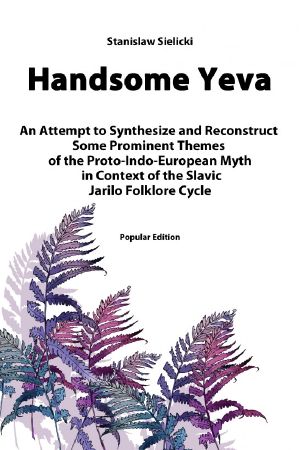Handsome Yeva

- Authors
- Sielicki, Stanislaw
- Publisher
- CreateSpace Independent Publishing Platform
- Tags
- vedas , myth retelling , fantasy , folklore , legends , slavic mythology , slavic myths , slavic folklore , indoeuropean , mythology
- ISBN
- 9781540650344
- Date
- 2016-11-28T00:00:00+00:00
- Size
- 0.15 MB
- Lang
- en
Do you like to listen to the stories sitting in front of the camping fire? Funny stories, scary stories, silly stories? I can guess, for you read this, - you do. And I do. And our ancestors - ancestors of most European nations and many Asian nations - a Proto-Indo-European people, loved to do so. We don't exactly know when and where their culture emerged - 3-5 (or maybe 7-9, or even 10-13) thousand years ago somewhere in between Europe, Anatolia, Caucasus, Volga steppes, or Hindustan peninsula. However, we know the exact date and place when and where the idea of the ancient unity of the languages, cultures and mythologies, now known as Indo-European, had entered scientific circulation. That happened on February 2nd, 1786 in Calcutta, where British philologist Sir William "Oriental" Jones gave a lecture to the members of the Asiatick Society of Bengal. Since then, many bright scientists have worked in the field of reconstructing that culture which, although long gone, had affected our world so much. The typical way of bringing that ancient mythology back is to search for the similar narratives, personages, and specific vocabulary in the myths of contemporary Indo-European cultures. We now know a number of such persistent and ubiquitous stories; however, it would be fascinating to find more, perhaps not so popular, ancient Indo-European tales that did not leave many traces behind. Instead of looking for the common and known structures in many mythological narratives, we may want to look for the commonality of the hypothetical structure in the unknown fragments of the Proto-Indo-European reconstructions with the one or few myth(s) we know. One of the best resources to look for the unknown, still, in between the known, is Balto-Slavic mythology. We don't have any primary sources for it as we do with Greco-Roman and Indo-Iranian cultures, and we don't have extensive ancient or early Medieval sources on the mythology as we do with Germanic and Celtic cultures. However, we have some middle and late Medieval secondary sources, and folklore collected in the eighteenth, nineteenth, and twentieth centuries. There were some significant efforts to reconstruct Balto-Slavic mythology by the mythological school of folklore in the late nineteenth century, and by the structuralist and ethnolinguistic schools in the late twentieth century. This reconstruction is inspired by those efforts, and extends them by adding reconstructions of the voids left by previous researchers, primarily from the Indo-Iranian mythology, but also other Indo-European mythologies. The contemporary, fantasy style of the story is chosen in an attempt to reconstruct not only the text, but also the whole experience. Imagine that, so many thousand years ago, you are among those people who sat in front of the camping fires during the dark and cold nights in the prairies and mountains of the Indo-European motherland, and loved to listen to those ancient stories. What authors would you read, listen to, and watch today? Most likely that would be someone like J. R. R. Tolkien, J. K. Rowling or Ursula K. Le Guin. And for this audience, we offer our reconstruction. Please, enjoy the reconstruction and loose translations of the original Baltic and Slavic poetry the reconstruction was based upon, as well as the wonderful illustrations of the very talented artist Cristiana Rodrigues.